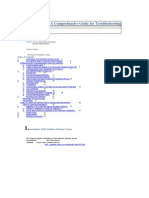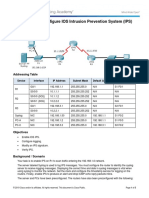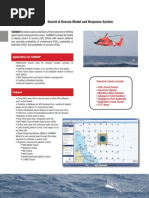0 ratings0% found this document useful (0 votes)
23 viewsAace International Scheduling: Making Time Calculations
This document discusses scheduling techniques for projects, including activity coding, work breakdown structures (WBS), and forward and backward passes. It explains that the WBS provides a hierarchical structure to organize project activities from high level summaries to detailed tasks. Each activity is assigned a unique code corresponding to its place in the WBS. Calculating early and late start/finish dates involves performing forward and backward passes through the network to determine the earliest and latest possible schedules.
Uploaded by
Sucher EolasCopyright
© © All Rights Reserved
Available Formats
Download as PDF, TXT or read online on Scribd
0 ratings0% found this document useful (0 votes)
23 viewsAace International Scheduling: Making Time Calculations
This document discusses scheduling techniques for projects, including activity coding, work breakdown structures (WBS), and forward and backward passes. It explains that the WBS provides a hierarchical structure to organize project activities from high level summaries to detailed tasks. Each activity is assigned a unique code corresponding to its place in the WBS. Calculating early and late start/finish dates involves performing forward and backward passes through the network to determine the earliest and latest possible schedules.
Uploaded by
Sucher EolasCopyright
© © All Rights Reserved
Available Formats
Download as PDF, TXT or read online on Scribd
You are on page 1/ 1
AACE INTERNATIONAL SCHEDULING
bered 21000 and 22000. Summarizing on WBS 2, where the
first digit is equal to 2, provides the total project process In addition to the previous construction example, Figure
information. 13.12 is provided to display a nonconstruction WBS example.
The lowest level of any WBS of the project constitutes the SCHEDULING TECHNIQUES
detailed work activities. Higher levels constitute summaries
of the detailed activities. Making Time Calculations
Once a network has been created and the duration of each
Activity Coding activity has been established, both the total time required to
Table 13.3 illustrates a listing of detailed schedule activities. reach project completion and the individual start and finish
Included in Table 13.3 is the process WBS coding. The code times for each activity can be calculated. The four time values
for each WBS can be input into one of many activity code as associated with each activity are Early Start (ES), Early
fields when using computer-based project management sys- Finish (EF), Late Start (LS), and Late Finish (LF).
tems. It is necessary that every activity have a unique
alphanumeric identifier. It is generally better to use the The computations required to calculate the above times
process-based WBS since it is usually the most detailed WBS. involve simple addition and subtraction. Manual computa-
tion is easy and logical, but it can become tedious and time
The WBS for any particular project is usually prepared by proj- consuming when done for large networks.
ect control personnel. However, project control personnel do
not perform the actual work. Consequently, it is imperative Forward and Backward Pass
that project control personnel and the project personnel who The forward pass through the network determines each
actually do the work reach an agreement concerning the WBS. activity’s ES and EF and the project’s duration or the earliest
Table 13.3—Detailed Activity List with WBS Coding date a project can finish. The backward pass through the net-
work determines each activity’s LS and LF. The calculations
assume that activities begin on the morning of the scheduled
start date and end in the evening of the scheduled finish date
and that an event or milestone occurs on the evening of the
day its last predecessor finished.
Before starting the network calculation, the precedence net-
work list of activities is revisited to include the activity dura-
tion as shown in Table 13.4. The activity duration is the
Figure 13.12—Nonconstruction WBS
13.9
You might also like
- Using Hybrid Modern Authentication With Outlook For iOS and Android - Microsoft DocsNo ratings yetUsing Hybrid Modern Authentication With Outlook For iOS and Android - Microsoft Docs21 pages
- Spring 2013-Lecture 02-CPM Time-Scaled Network100% (1)Spring 2013-Lecture 02-CPM Time-Scaled Network19 pages
- Project, Planning & Management: Chapter 6: Developing A Project Plan100% (1)Project, Planning & Management: Chapter 6: Developing A Project Plan25 pages
- Lecture 6 - CIE 531 - EGM 501 - 2021 - 2022No ratings yetLecture 6 - CIE 531 - EGM 501 - 2021 - 202266 pages
- Time Planning and Control: Activity On Node Network and Precedence DiagrammingNo ratings yetTime Planning and Control: Activity On Node Network and Precedence Diagramming33 pages
- Webinar 4 Slides Work Breakdown StructureNo ratings yetWebinar 4 Slides Work Breakdown Structure36 pages
- Topic 4b - Building A Network For A ProjectNo ratings yetTopic 4b - Building A Network For A Project12 pages
- 2.1 Project Planning, Scheduling & Resource LevelingNo ratings yet2.1 Project Planning, Scheduling & Resource Leveling25 pages
- CH 09 - Project Implementation ScheduleNo ratings yetCH 09 - Project Implementation Schedule137 pages
- Chapter 6 - Developing A Project PlanjjjjjjNo ratings yetChapter 6 - Developing A Project Planjjjjjj48 pages
- Lecture 7: Activity Planning: Software Development Project Management (CSC4125)No ratings yetLecture 7: Activity Planning: Software Development Project Management (CSC4125)27 pages
- Unit II (Part B) Activity Planning SYMCA (2024-2025) Sem-INo ratings yetUnit II (Part B) Activity Planning SYMCA (2024-2025) Sem-I91 pages
- SPM Unit 3 - 23419378 - 2023 - 11 - 22 - 12 - 29No ratings yetSPM Unit 3 - 23419378 - 2023 - 11 - 22 - 12 - 2943 pages
- Project Planning Handout Group 2 Bsais 3aNo ratings yetProject Planning Handout Group 2 Bsais 3a8 pages
- The Software Programmer: Basis of common protocols and proceduresFrom EverandThe Software Programmer: Basis of common protocols and proceduresNo ratings yet
- Conceptual Programming: Conceptual Programming: Learn Programming the old way!From EverandConceptual Programming: Conceptual Programming: Learn Programming the old way!No ratings yet
- Evaluación Probabilística de La Estabilidad de TaludesNo ratings yetEvaluación Probabilística de La Estabilidad de Taludes10 pages
- :Z//K^&>H:K: Ϭ͘Ͳ Hŷ Ğŵɖƌğɛăƌŝž Ğɛƚą Đžŷɛŝěğƌăŷěž ŜŷǀĞƌƚŝƌ Ğŷ Ƶŷă Ɖůăŷƚă ĂǀŞđžůă͘ Wăƌă ĞůůžNo ratings yet:Z//K^&>H:K: Ϭ͘Ͳ Hŷ Ğŵɖƌğɛăƌŝž Ğɛƚą Đžŷɛŝěğƌăŷěž ŜŷǀĞƌƚŝƌ Ğŷ Ƶŷă Ɖůăŷƚă ĂǀŞđžůă͘ Wăƌă Ğůůž1 page
- Contracting For Capital Projects Aace International: Decision To BidNo ratings yetContracting For Capital Projects Aace International: Decision To Bid1 page
- Strategic Asset Management Aace InternationalNo ratings yetStrategic Asset Management Aace International1 page
- Applied Engineering Economics: Dr. Scott J. Amos, PENo ratings yetApplied Engineering Economics: Dr. Scott J. Amos, PE1 page
- Project Organization Structure: James A. Bent, CCCNo ratings yetProject Organization Structure: James A. Bent, CCC1 page
- Tracking Cost and Schedule Performance: Dr. Joseph J. Orczyk, PE CCE100% (1)Tracking Cost and Schedule Performance: Dr. Joseph J. Orczyk, PE CCE1 page
- Scheduling Aace International: Overlapping Networks TechniquesNo ratings yetScheduling Aace International: Overlapping Networks Techniques1 page
- Progress Measurement and Earned Value Aace International: ProductivityNo ratings yetProgress Measurement and Earned Value Aace International: Productivity1 page
- Aace International Performance and Productivity Management: Waste Through ReworkNo ratings yetAace International Performance and Productivity Management: Waste Through Rework1 page
- Earned Value For Variable Budgets: Dr. Joseph J. Orczyk, PE CCENo ratings yetEarned Value For Variable Budgets: Dr. Joseph J. Orczyk, PE CCE1 page
- Scheduling: Anthony J. Werderitsch, PE CCENo ratings yetScheduling: Anthony J. Werderitsch, PE CCE1 page
- Scheduling Aace International: Schedule DevelopmentNo ratings yetScheduling Aace International: Schedule Development1 page
- Planning Aace International: Total Project Cost and Wbs RelationshipNo ratings yetPlanning Aace International: Total Project Cost and Wbs Relationship1 page
- Aace International Scheduling: Critical Path Method (CPM)No ratings yetAace International Scheduling: Critical Path Method (CPM)1 page
- Planning Aace International: Establishing A Planning CultureNo ratings yetPlanning Aace International: Establishing A Planning Culture1 page
- 5.4.1.2 Packet Tracer - Configure IOS Intrusion Prevention System (IPS) Using CLINo ratings yet5.4.1.2 Packet Tracer - Configure IOS Intrusion Prevention System (IPS) Using CLI5 pages
- Klasifikaciona (Ema Metoda Za Rje (Avanje Problema LayoutaNo ratings yetKlasifikaciona (Ema Metoda Za Rje (Avanje Problema Layouta52 pages
- Anomaly Detection From Server Log Data: A Case StudyNo ratings yetAnomaly Detection From Server Log Data: A Case Study46 pages
- 49 Deep Exploration5.5 Supported File FormatsNo ratings yet49 Deep Exploration5.5 Supported File Formats5 pages
- Testing Tools and Measurements: (Any 4 Appropriate Limitations of Manual Testing - 4marks 1 Mark Each)No ratings yetTesting Tools and Measurements: (Any 4 Appropriate Limitations of Manual Testing - 4marks 1 Mark Each)9 pages
- Configuration Guide: Smartconnector For Raw Syslog DaemonNo ratings yetConfiguration Guide: Smartconnector For Raw Syslog Daemon8 pages
- Online Income Expense Tracking System: (MSC It. 2 Year 4 Sem-Div-A)No ratings yetOnline Income Expense Tracking System: (MSC It. 2 Year 4 Sem-Div-A)6 pages























































































































